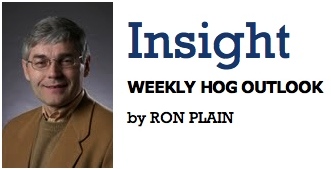Ron Plain’s hog report
Iowa State University calculations put the average production cost for Iowa barrows and gilts marketed in April at $64.37/cwt (live). April’s cost was record high for the third consecutive month. ISU estimates the April profit at $13.82/head marketed.
Through April 23, the number of feeder pigs imported from Canada was down 2.2% from the comparable period in 2010. USDA’s weekly data indicates imports of Canadian barrows and gilts for slaughter were down 4.1% and slaughter sow imports were down 12.9%.
The Bureau of Labor Statistics says 244 thousand jobs were added in April, the biggest monthly increase since May. However, the unemployment rate increased from 8.8% to 9.0% due to a surge in people re-entering the labor market.
June crude oil futures closed at $98.45/barrel on Friday, down $15.07 from Monday’s close. The national average gasoline price reached $4/gallon this week. Barring a rebound in crude oil, gasoline prices should start dropping soon.
Pork cutout, cash hogs and hog futures were all lower for the second week in a row. The national average negotiated carcass price for direct delivered hogs on the morning report today was $87.58/cwt, down $2.54 from last Friday. The eastern corn belt average this morning was $86.42/cwt while the western corn belt average was $90.57/cwt, $4.15 higher than in the east. Iowa-Minnesota hogs averaged $91.55/cwt on the morning report. Friday’s top live hog price at both Peoria and Zumbrota was $61/cwt. The top for interior Missouri hogs was $63/cwt, down $1.50 from the previous Friday.
USDA’s Thursday afternoon calculated pork cutout value was $90.47/cwt, down $1.29 from the previous Thursday. Ham prices were higher, but loins, butts, and bellies were lower. Pork bellies are down $24.33/cwt from their price just three weeks ago. This morning’s national average hog carcass price was 97% of the pork cutout value. The morning hog price in the western corn belt was above yesterday’s cutout value. That is obviously not sustainable. Expect lower hog prices next week.
Hog slaughter totaled 1.989 million head this week, up 2.0% from the week before but down 0.2% compared to the same week last year. Iowa-Minnesota live weights for barrows and gilts last week averaged 273.3 pounds, up 0.4 pound from the week before and up 2.8 pounds compared to a year earlier.
The May lean hog futures contract ended the week at $93.35/cwt, down $1.92 from the previous Friday. The June contract settled Friday at $92.37/cwt. July hogs settled at $92.60 and August hogs ended at $93.95/cwt.
USDA’s latest crop progress report estimates 13% of the corn acres was planted by May 1, down from 66% planted on that date last year and a 5-year average of 40% planted.
The May corn futures contract lost 71 cents this week to end at $6.8275/bushel. December corn ended the week at $6.4025/bushel.




Comments
I read this article with interest, because the transport of our food animals is generally the most inhumane, stressful part of their entire miserable lives. I had to chuckle when I read this. "That physical exertion of getting up into the top deck or getting down into the bottom deck and the reverse coming off the truck has an effect on meat quality,” Gonyou says."
Now, why would that be? Could it be because the animals have NEVER had any reasonable exercise their whole lives? After keeping a sow in a gestation crate for three years, you are surprised they cannot handle a ramp? You are workinjg to decrease the stresses involved in transport? Honestly. I thought farmers had common sense. I would also call your attention to the use of ractopamine. It is illegal in many countires, including China & Taiwan, both countries not exactly bastions of humane animal handling. quote "feeding ractopamine to pigs does affect behavior and physiology. Pigs that are more difficult to move are more likely to be subjected to rough handling and increased stress during transportation, implying reduced welfare, increased workload for the handlers and, potentially, poorer meat quality." I have taken pork out of my diet. Feeding what amounts to an amphetamine to our food animals is folly, only to increase the effiency/value to the producer. The animal's welfare is not taken into acount. I am not for animal rights. I am for animal welfare. Continue to treat animals like little insensate boxes of protein, and watch your consumers switch to tofu. The CFIA should be ashamed that it allows the use of this drug in both cattle and pigs. The producers should be ashamed, too.